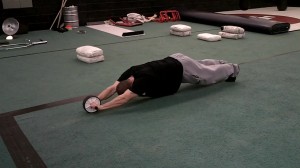 While I'd argue you'd be hard-pressed to find a better exercise for the anterior core than the standing rollout, the fact of the matter is that the exercise is way, WAY too advanced for most people. For example, when I watch someone do a standing rollout for the first time, one of three things happens:
1) They fall flat on their face.
2) Their lower back quickly falls into hyperextension (excessive arching, or "bowing"), thus defeating the entire purpose of the exercise and putting their spine in danger.
3) Their spleen shoots out of their midsection, splattering the wall beside them.
While I'd argue you'd be hard-pressed to find a better exercise for the anterior core than the standing rollout, the fact of the matter is that the exercise is way, WAY too advanced for most people. For example, when I watch someone do a standing rollout for the first time, one of three things happens:
1) They fall flat on their face.
2) Their lower back quickly falls into hyperextension (excessive arching, or "bowing"), thus defeating the entire purpose of the exercise and putting their spine in danger.
3) Their spleen shoots out of their midsection, splattering the wall beside them.
Not to fear! There is still a way to receive the benefits of rollouts without your form looking like poo. Enter the standing rollout to wall; a fantastic variation for those who have mastered plank and stability ball rollout variations:
How to do it: First, be honest with yourself. Only go as far away from the wall as you can without your low back sinking, or "bowing" toward the floor. Otherwise your time will be just as well spent doing something equally productive, such as throwing your intervertebral discs into a blender.
SQUEEZE your glutes hard, and posteriorly tilt your pelivs - aka, the humping motion....I apologize as that's not the most G-rated way to describe it but it seems to help the majority of people conceptualize it. Also, do your best not to fall into forward head posture, as people (myself included) tend to "reach" with their head on these more than any other trunk exercise.
Do 2-3 sets of 5-8 reps, beginning on the low end of the spectrum. No need to rush things here.
For the strength coaches in the crowd: Standing rollouts help with anti-extension of the trunk and assist in taking those who live in extension (primarily athletes) and drawing them out of that extended, anteriorly-tilted posture.
For the gym-rats out there: Nothing will get those abz a-blazin' (or sore) like standing rollouts will. Just be sure you've spent ample time mastering planks, fallouts, stir-the-pots, and the drills I outlined in this video:
